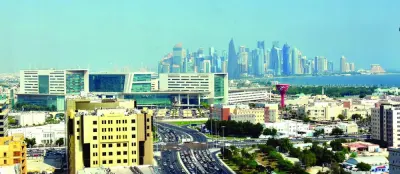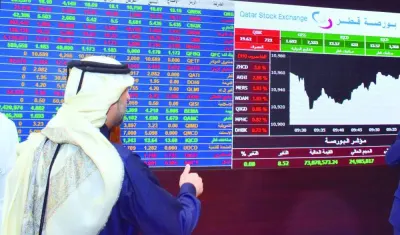Awaiting clues from the US Federal Reserve’s decision on the interest rate, the Qatar Stock Exchange on Tuesday lost more than 43 points amidst heightened trading volumes.The foreign funds were seen increasingly net profit takers as the 20-stock Qatar Index shed 0.42% to 10,405.45 points, although it touched an intraday high of 10,482 points.The transport and banking counters witnessed higher than average selling pressure in the main market, whose year-to-date losses widened further to 3.93%.As much as 51% of the traded constituents were in the red in the main bourse, whose capitalisation was down QR0.21bn or 0.03% to QR604.3bn on the back of microcap segments.The Gulf institutions turned net sellers in the main market, which saw 0.23mn exchange traded funds (sponsored by Masraf Al Rayan and Doha Bank) valued at QR0.53mn trade across 53 deals.The local retail investors’ weakened net buying had its influence in the main bourse, which saw no trading of treasury bills.The domestic funds’ lower net buying also had its say in the main market, which saw no trading of sovereign bonds.The Islamic index was seen declining slower than the main barometer in the main bourse, whose trade turnover and volumes were on the increase.The Total Return Index lost 0.42%, the All Share Index by 0.29% and the All Islamic Index by 0.31% in the main market.The transport sector index declined 0.71%, banks and financial services (0.42%), consumer goods and services (0.36%), industrials (0.24%) and insurance (0.24%); while telecom and real estate gained 1.22% and 0.16% respectively.Major losers in the main bourse included Doha Bank, Milaha, Masraf Al Rayan, QIIB and Qatar Islamic Bank.In the venture market, Al Mahhar Holding saw its shares depreciate in value.Nevertheless, Alijarah Holding, Ahlibank Qatar, Mazaya Qatar, Al Faleh Educational Holding, Salam International Investment, Qatar German Medical Devices, Estithmar Holding, Ezdan, Vodafone Qatar and Ooredoo were among the gainers in the main market.The foreign institutions’ net profit booking increased noticeably to QR9.37mn compared to QR8.41mn on September 16.The Gulf institutions turned net sellers to the tune of QR2.31mn against net buyers of QR5.65mn the previous day.The local individuals’ net buying weakened perceptibly to QR0.94mn compared to QR2.29mn on Monday.The domestic institutions’ net buying declined marginally to QR5.76mn against QR6.37mn on September 16.However, the Arab individuals were net buyers to the extent of QR3.76mn compared with net sellers of QR1.21mn the previous day.The foreign retail investors turned net buyers to the tune of QR1.53mn against net profit takers of QR1.67mn on Monday.The Gulf individual investors’ net selling weakened significantly to QR0.32mn compared to QR3.03mn on September 16.The Arab institutions had no major net exposure for the second straight session.Trade volumes in the main market soared 92% to 263.86mn shares, value by 30% to QR435.85mn and transactions by 18% to 14,917.In the venture market, trade volumes almost tripled to 0.5mn equities and value also almost tripled to QR1.17mn but on flat deals at 26.

Santhosh V. Perumal
Santhosh V. Perumal, a postgraduate in Econometrics with an advance qualification in Capital Markets and Financial Services, is Gulf Times' journalist. His coverage areas are debt and equity, hydrocarbons, international trade, environment, banks, insurance and real estate. Previously, he was in New Delhi, India as Senior Finance Correspondent of PTI.
Most Read Stories























